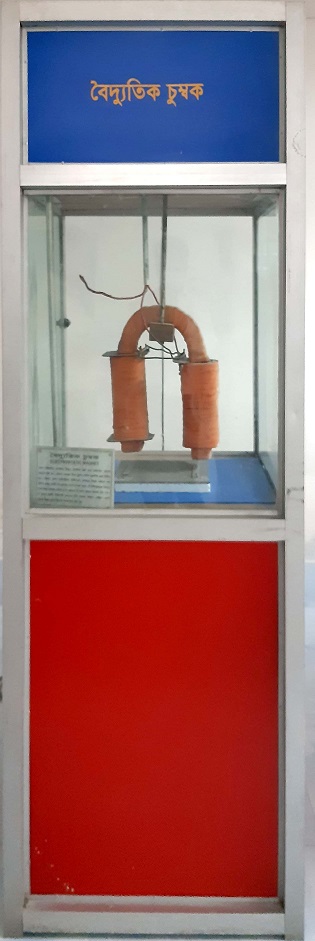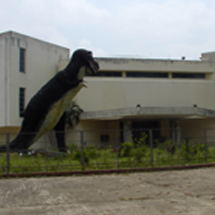তড়িৎ চুম্বক
এই প্রদর্শনীবস্তুটি তড়িচ্চুম্বক এবং এটাকে কিভাবে তৈরি করা হয় তা প্রদর্শন করে। যখন সলিনয়েডের মধ্য দিয়ে একমুখী বিদ্যুৎ প্রবাহ (ডি.সি.) চালনা করা হয়, তখন সলিনয়েডটি দন্ড চুম্বকের ন্যায় আচরণ করে। যদি সলিরয়েডটির আকার অশ্বের খুরের মত হয়, তবে সলিনয়েডটি অশ্ব খুরাকৃতি চুম্বকের ন্যায় আচরণ করে। বিদ্যুৎ প্রবাহ অপসারণ করলে সলিনয়েডটিতে কোন চুম্বকত্ব থাকে না। যদি সলিনয়েডটির অভ্যন্তরদেশ নরম লোহা দ্বারা পূর্ণ করা হয়, তবে চুম্বকের শক্তি বৃদ্ধি পায়। তড়িচ্চুম্বকের মেরুত্ব বিদ্যুৎ প্রবাহের দিক কর্তৃক নিণীত হয়। সলিনয়েডের প্রান্তের মধ্য দিয়ে পর্যবেক্ষণে যদি বিদ্যুৎ প্রবাহ ঘড়ির কাটার বিপরীত মুখী হয়, তবে ঐ প্রান্তটি উত্তর মেরু হবে। অন্যভাবে সলিনয়েডের প্রান্তের মধ্য দিয়ে পর্যবেক্ষণে যদি বিদ্যুৎ প্রবাহ ঘড়ির কাটার সমমুখী হয়, তবে ঐ প্রান্তটি দক্ষিণ মেরু হবে। সংক্ষিপ্ত ইতিহাস: ১৮২০ সালে ডেনিশ বিজ্ঞানী হান্স ক্রিস্টিয়ান ওয়েরস্টেড আবিষ্কার করেন যে বৈদ্যুতিক প্রবাহ চৌম্বক ক্ষেত্র সৃষ্টি করে। ১৯২৪ সালে ব্রিটিশ বিজ্ঞানী উইলিয়াম স্টার্জিয়ন তড়িচ্চুম্বক তড়িচ্চুম্বক উদ্ভাবণ করেন। তাঁর প্রথম তড়িচ্চুম্বকটি একটি অশ্বখুরাকৃতি লোহার খন্ড যা প্রায় ১৮ পাকের নগ্ন (সেকালে অপরিবাহীর আচ্ছাদনের প্রচলন ছিল না) তামার তারে আচ্ছন্ন করা হয়েছিল। পাকীয় আচ্ছাদন বিছিন্ন করতে লোহার উপর বার্ণিশ করা হয়েছিল। যখন কুণ্ডলীটির মধ্যদিয়ে কোন বৈদ্যুতিক প্রবাহ পাঠানো হত, তখন লৌহটি চুম্বকে পরিণত হত, এবং অপরাপর লৌহের টুকরা আকর্ষন করত; যখন বৈদ্যুতিক প্রবাহ বন্ধ করা হত, এটা চুম্বকায়ন হারিয়ে ফেলত। যদিও এটি মাত্র সাত আউন্স (প্রায় ২০০ গ্রাম) ওজন উঁচিয়ে স্টার্জিয়ন এর ক্ষমতা প্রদর্শন করেছিলেন, এটি ৯ পাউন্ড (প্রায় ৪ কিলোগ্রাম) ওজন উত্তোলনে সক্ষম হয়েছিল যখন একক-কোষ ব্যাটারি থেকে বৈদ্যুতিক প্রবাহ প্রযুক্ত হয়। যাইহোক, স্টার্জিয়নের চুম্বক দুর্বল ছিল কারণ তাঁর ব্যবহৃত অনাচ্ছাদিত তার কোরের চতুর্দিকে শুধুমাত্র একক স্তরের আচ্ছাদন দিতে পেরেছিল, যা পাক সংখা সীমিত করেছিল। ১৮২৭ থেকে শুরু করে, মার্কিন বিজ্ঞানী জোসেফ হেনরি ধারাক্রমে উন্নত করেন এবং তড়িচ্চুম্বককে জনপ্রিয় করেন। সিল্ক সুতা দ্বারা আচ্ছাদিত তার ব্যবহার করে তিনি কোরের চতুর্দিকে একাধিক স্তর তারের আচ্ছাদন দিতে সক্ষম হয়েছিলেন, এভাবে সহস্র সহস্র পাকের শক্তিশালী চুম্বক তৈরি করেছিলেন, এর মধ্যের একটি ২০৬৩ পাউণ্ড (৯৩৬ কেজি) উত্তোলনে সমর্থ হয়েছিল। তড়িচ্চুম্বককের প্রথম প্রধান ব্যবহার ছিল টেলিগ্রাফের সাউন্ডারে। ফেরোম্যাগনেটিক কোর কিভাবে কাজ করে, এর উপর সর্বপ্রথম ১৯০৬ সালে ফরাসি পদার্থবিজ্ঞানী পিয়ের-আর্নেস্ট উইস কর্তৃক চুম্বকীয় ডোমেইন তত্ত্ব প্রস্তাবিত হয়, এবং ১৯২০ সালের অয়ের্নার হাইসেনবার্গ, লেভ ল্যান্ডো, ফেলিক্স ব্লচ এবং অন্যদের কাজের মাধ্যমে ফেরোম্যাগনেটিজমের উপর আধুনিক কোয়ান্টাম বলবিজ্ঞানের তত্ত্ব বিস্তার লাভ করে।

This exhibit demonstrates an electromagnet and how it is prepared. A helical coil of electrical conductor is known as solenoid. When direct current (D.C) is passed through the solenoid, then the solenoid behaves like a bar magnet. If the solenoid is shaped like horseshoe, then the solenoid behaves like a horseshoe magnet. After withdrawal of current, there is no magnetism in the solenoid. If the core of the solenoid is filled with soft iron, then strength of magnet increases. The polarity of electromagnet is determined by the direction of current. Observing through the end of the solenoid in which current flows in anti-clockwise direction, the end will be North Pole. Another way, observing through the end of the solenoid in which current flows in clockwise direction, the end will be South Pole. Brief history: Danish scientist Hans Christian Orsted discovered in 1820 that electric currents create magnetic fields. British scientist William Sturgeon invented the electromagnet in 1824. His first electromagnet was a horseshoe-shaped piece of iron that was wrapped with about 18 turns of bare copper wire (insulated wire didn't exist yet). The iron was varnished to insulate it from the windings. When a current was passed through the coil, the iron became magnetized and attracted other pieces of iron; when the current was stopped, it lost magnetization. Sturgeon displayed its power by showing that although it only weighed seven ounces (roughly 200 grams), it could lift nine pounds (roughly 4 kilos) when the current of a single-cell battery was applied. However, Sturgeon's magnets were weak because the uninsulated wire he used could only be wrapped in a single spaced out layer around the core, limiting the number of turns. Beginning in 1827, US scientist Joseph Henry systematically improved and popularized the electromagnet. By using wire insulated by silk thread he was able to wind multiple layers of wire on cores, creating powerful magnets with thousands of turns of wire, including one that could support 2,063 lb (936 kg). The first major use for electromagnets was in telegraph sounders. The magnetic domain theory of how ferromagnetic cores work was first proposed in 1906 by French physicist Pierre-Ernest Weiss, and the detailed modern quantum mechanical theory of ferromagnetism was worked out in the 1920s by Werner Heisenberg, Lev Landau, Felix Bloch and others.


.jpg)






















